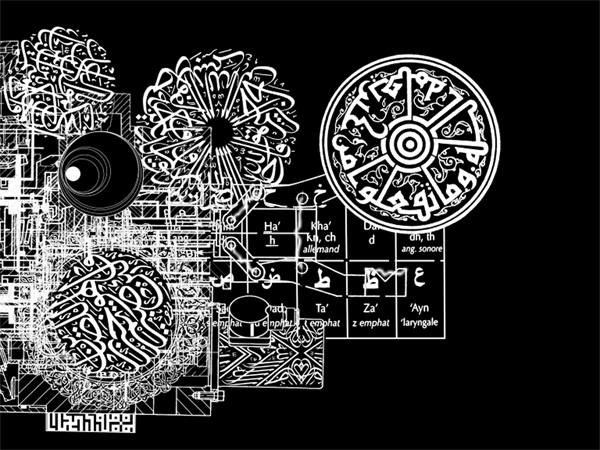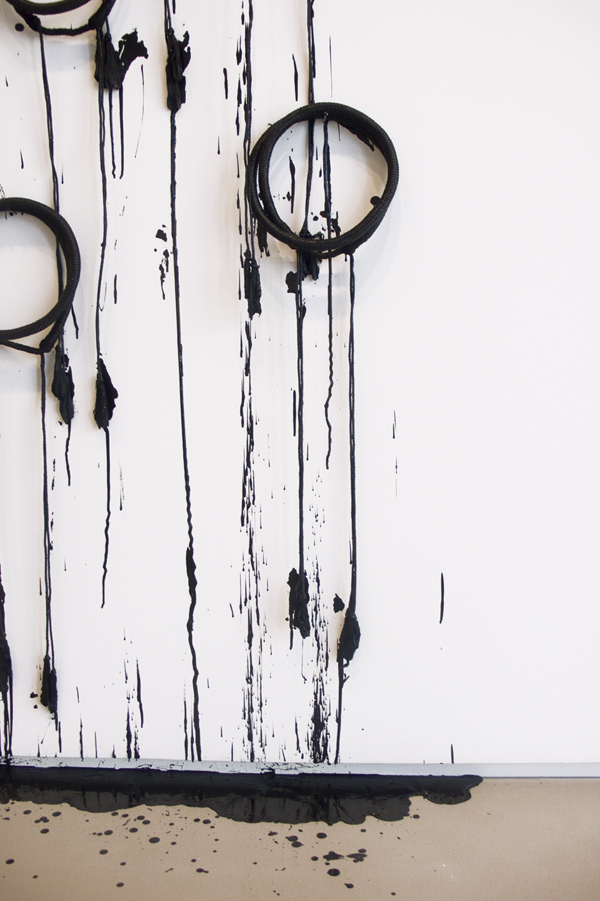Shows
Mounir Fatmi’s “Oriental Accident”


Moroccan artist Mounir Fatmi’s second solo show at Lombard Freid Projects, “Oriental Accident” continued Fatmi’s examination of political issues surrounding the Arab Spring protests, which began in December 2010, and included six works never before shown in the United States.
The central work Oriental Accident (2011), from which the exhibition takes its name, is a Persian rug with numerous embedded speakers, which have nails scattered on them to show the physical force of the protest chants when amplified. These are the cries of Arab Spring protesters in the Maghreb, Egypt and the Middle East, recorded by the artist in 2010, which continue to be wailed in Syria.
Projected onto the backroom wall of the exhibition space, the film Modern Times, A History of the Machine (2009–2010), is a 15-minute cacophony of rotorelief-esque circles, patterned with calligraphic text from the Quran. The text represents Islam’s religious figures as fundamental components of Arabic governments and societies, and the circles, which continuously spin in a linear, abstract matrix, create the sense of a futile and hypnotic machine. Despite the energy exuded from the metaphorical bureaucratic mechanism, it produces nothing of substance and thus no change—alluding to the protesters’ frustration, in Egypt and elsewhere, with their governments’ seemingly stagnant incapacity to reform.

Many of the protesters, young and old, were simply calling for jobs and more equitable access to the region’s resource wealth. On another wall, Oil Oil Oil Oil (2011), comprised a collection of 25 agals (a headband worn by Arab men to keep the keffiyeh headdress in place) dipped in black paint and hung while still wet, leaves cascades of dripping oil-like paint beneath. This investigates the Middle East’s best-known source of both revenue and international tension. Here the traditional agals now look like mounted trophy heads, the dripping paint suggesting spilled blood or oil.

The negative space within the circular headbands also references “the year zero,” a motif Fatmi revisits in several works. As with the bas-relief work, The Year Zero (2012), formed out of coaxial antenna cables and cable pins, the “zero” refers to the new but uncertain beginnings the Spring has brought. For Egyptians, January 25, 2011 is the “zero” separating the past from the ongoing promise of the present.
To compliment the exhibition, Fatmi also created a website that takes the image of Oriental Accident as a backdrop for related texts, additional links and all of the audio elements of the exhibited work, which includes 22 sounds of protesters, to symbolize the 22 countries of the Arab league. Authoritarian rule is not the only thing critiqued within the exhibition's group of works. An underlying discontent with mass media’s portrayal of the Arab Spring is further explored on the website. Organized by countries, links to various news agencies are provided to reveal the contrast between national media and the events in the streets. In this way Fatmi deconstructs the framing device of the nation to give a more multi-dimensional, and accurate, representation of the protests. The site also includes an article by the artist reflecting on the protests, titled “My father has lost all his teeth, I can bite him now,” originally published in the French film magazine Cahiers du Cinéma, in April 2011.
The earlier hopeful undertones of Fatmi’s work about the Arab Spring in “Promise of a Future,” at the 2011 Venice Biennale, have been replaced here by both uncertainty and a nostalgia for the initial powerful impact of the Arab Spring. In this sense, “Oriental Accident” embodies the shifting views of onlookers and participants alike, and the fear that fallen regimes may come back to power during this time of interim governments. While we wait to see what kind of governments will emerge and how they will address the pleas of the initial demonstrators, Fatmi’s exhibition attests to a continuous strive for change.







